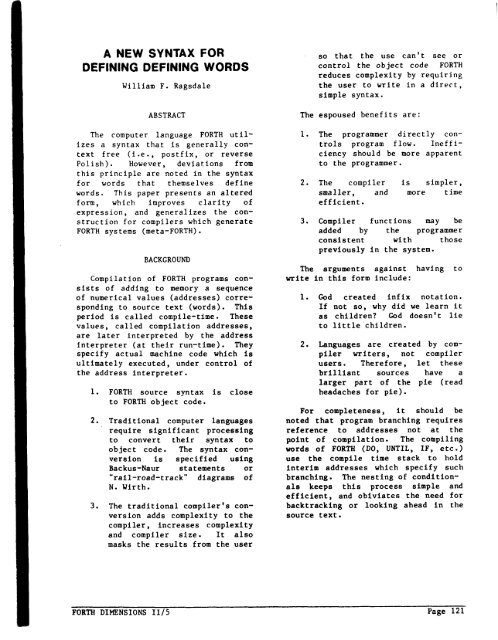5 - Forth Interest Group
5 - Forth Interest Group
5 - Forth Interest Group
You also want an ePaper? Increase the reach of your titles
YUMPU automatically turns print PDFs into web optimized ePapers that Google loves.
A NEW SYNTAX FOR<br />
DEFINING DEFINING WORDS<br />
William F. Ragsdale<br />
ABSTRACT<br />
The computer language FORTH util-<br />
izes a syntax that is generally con-<br />
text free (i.e., postfix, or reverse<br />
Polish). However, deviations from<br />
this principle are noted in the syntax<br />
for words that themselves define<br />
words. This paper presents an altered<br />
form, which improves clarity of<br />
expression, and generalizes the con-<br />
struction for compilers which generate<br />
FORTH systems (meta-FORTH).<br />
BACKGROUND<br />
Compilation of FORTH programs con-<br />
sists of adding to memory a sequence<br />
of numerical values (addresses) corre-<br />
sponding to source text (words). This<br />
period is called compile-time. These<br />
values, called compilation addresses,<br />
are later interpreted by the address<br />
interpreter (at their run-time). They<br />
specify actual machine code which is<br />
ultimately executed, under control of<br />
the address interpreter.<br />
1. FORTH source syntax is close<br />
to FORTH object code.<br />
2. Traditional computer languages<br />
require significant processing<br />
to convert their syntax to<br />
object code. The syntax con-<br />
version is specified using<br />
Backus-Naur statements or<br />
"rail-road-track" diagrams of<br />
N. Wirth.<br />
3. The traditional compiler's con-<br />
version adds complexity to the<br />
compiler, increases complexity<br />
and compiler size. It also<br />
masks the results from the user<br />
FORTH DIMENSIONS II/5<br />
so that the use can't see or<br />
control the object code FORTH<br />
reduces complexity by requiring<br />
the user to write in a direct,<br />
simple syntax.<br />
The espoused benefits are:<br />
1. The programmer directly con-<br />
trols program flow. Inef f i-<br />
ciency should be more apparent<br />
to the programmer.<br />
2. The compiler is simpler,<br />
smaller, and more time<br />
efficient.<br />
3. Compiler functions may be<br />
added by the programmer<br />
consistent with those<br />
previously in the system.<br />
The arguments against having to<br />
write in this form include:<br />
1. God created infix notation.<br />
If not so, why did we learn it<br />
as children? God doesn't lie<br />
to little children.<br />
2. Languages are created by com-<br />
piler writers, not compiler<br />
users. Therefore, let these<br />
brilliant sources have a<br />
larger part of the pie (read<br />
headaches for pie).<br />
For completeness, it should be<br />
noted that program branching requires<br />
reference to addresses not at the<br />
point of compilation. The compiling<br />
words of FORTH (DO, UNTIL, IF, etc.)<br />
use the compile time stack to hold<br />
interim addresses which specify such<br />
branching. The nesting of condition-<br />
als keeps this process simple and<br />
efficient, and obiviates the need for<br />
backtracking or looking ahead in the<br />
source text.<br />
Page 121
















